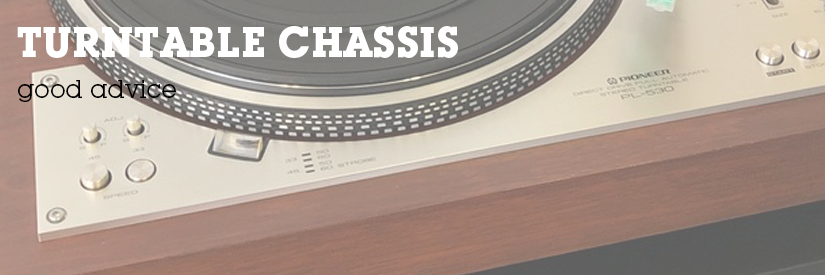Turntable Chassis
- Posted on

The first and most important part of the job of a turntable is to spin a record at an even speed and isolate it from outside vibration that will be picked up by the cartridge. That vibration can come from your speakers, your footsteps, and the motor of the turntable itself.
Round like a record baby. . . Most turntables are either belt drive or direct drive.
Direct Drive - the motor spindle is also (roughly speaking) the platter bearing. All DJ tables use DD for torque and control. They need to be very heavy duty if they're to be any good at all.
Belt Drive - a small motor sits off to one side and drive the platter via a pulley and rubber belt. Much simpler than direct drive and a convenient way to isolate the platter from the vibration of the motor, belt drive is the system used on most quality listening tables.
Note most turntables use AC motors for precise speed control. All AC motors vibrate as they turn. A 16 or 24 pole synchronous motor as found in high grade tables vibrates the least. Different motor power supply circuits also affect the sound and resonance of the motor.
Can you feel the vibe?. . . Speakers create resonance that travels through every solid structure in your house. You don't notice the walls shaking unless it's very loud and you're reliving your misspent youth but even at moderate volumes that energy will travel back to your turntable and feed back through the cartridge causing loss of detail most noticeable as rumble or boomy bass.
Tables seek to isolate the vinyl from unwanted energy usually by mounting the platter on some sort of suspension. Some tables (Dual, AR, Thorens, Linn, VPI) use springs under compression or extension to accomplish that. -- a good idea but more prone to skip when you waltz around. Other tables (Rega, Music Hall, Technics, Roksan) use a combination of materials to absorb and filter the vibrations out of the audible band before they get to the vinyl itself. Either way can work well, it just depends on the quality of the design and manufacture.
Another Note: A good quality listening table often sacrifices the convenience of speed control and auto return functions for simplicity, reliability and sound quality. You'll often move the belt to a bigger pulley to play 45rpm and the needle will sit in the run off groove at the end of the record. That may seem inconvenient until you find records that have music loops hidden in the run-off groove. Groovy!
So which is better, sorbothane vs. springs, metal vs. glass vs, wood vs. acrylic, etc. . .? Like anything, it's not really the materials but how they're used that makes a complex system like a turntable work well. The tables we like, recommend and sell span a wide variety of styles but a few things are consistent: quality, simplicity, careful engineering and manufacture make for the best sound.
Final Note for this month: You'll see several types of record mats on platters, usually felt or rubber. Again there's no one better material, but a record is never perfectly flat and consequently will only actually touch a rigid mat in three or so places. The softer surface of a felt mat contacts the record across more of the surface which is why it's commonly used. We're getting near a topic of fierce debate in some circles so we'll leave it at that.
